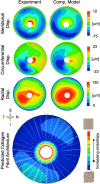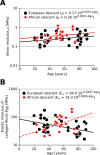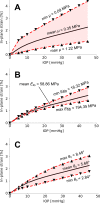Age- and race-related differences in human scleral material properties
- PMID: 25389203
- PMCID: PMC4266082
- DOI: 10.1167/iovs.14-14029
Age- and race-related differences in human scleral material properties
Abstract
Purpose: We tested the hypothesis that there are age- and race-related differences in posterior scleral material properties, using eyes from human donors of European (20-90 years old, n = 40 eyes) and African (23-74 years old, n = 22 eyes) descent.
Methods: Inflation tests on posterior scleral shells were performed while full-field, three-dimensional displacements were recorded using laser speckle interferometry. Scleral material properties were fit to each eye using a microstructure-based constitutive formulation that incorporates the collagen fibril crimp and the local anisotropic collagen architecture. The effects of age and race were estimated using Generalized Estimating Equations, while accounting for intradonor correlations.
Results: The shear modulus significantly increased (P = 0.038) and collagen fibril crimp angle significantly decreased with age (P = 0.002). Donors of African descent exhibited a significantly higher shear modulus (P = 0.019) and showed evidence of a smaller collagen fibril crimp angle (P = 0.057) compared to donors of European descent. The in-plane strains in the peripapillary sclera were significantly lower with age (P < 0.015) and African ancestry (P < 0.015).
Conclusions: The age- and race-related differences in scleral material properties result in a loss of scleral compliance due to a higher shear stiffness and a lower level of stretch at which the collagen fibrils uncrimp. The loss of compliance should lead to larger high frequency IOP fluctuations and changes in the optic nerve head (ONH) biomechanical response in the elderly and in persons of African ancestry, and may contribute to the higher susceptibility to glaucoma in these at-risk populations.
Keywords: computational modeling; extracellular matrix; glaucoma posterior segment.
Copyright 2014 The Association for Research in Vision and Ophthalmology, Inc.
Figures








References
-
- Nouri-Mahdavi K, Hoffman D, Coleman AL, et al. Predictive factors for glaucomatous visual field progression in the Advanced Glaucoma Intervention Study. Ophthalmology. 2004; 111: 1627–1635. - PubMed
-
- Leske MC, Heijl A, Hussein M, et al. Factors for glaucoma progression and the effect of treatment: the early manifest glaucoma trial. Arch Ophthalmol. 2003; 121: 48–56. - PubMed
-
- Gillespie BW, Musch DC, Guire KE, et al. The collaborative initial glaucoma treatment study: baseline visual field and test-retest variability. Invest Ophthalmol Vis Sci. 2003; 44: 2613–2620. - PubMed
-
- Drance S, Anderson DR, Schulzer M; Collaborative Normal-Tension Glaucoma Study Group. Risk factors for progression of visual field abnormalities in normal-tension glaucoma. Am J Ophthalmol. 2001; 131: 699–708. - PubMed
Publication types
MeSH terms
Substances
Grants and funding
LinkOut - more resources
Full Text Sources
Other Literature Sources
Medical

